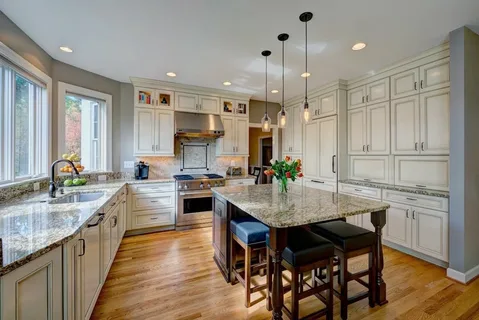Remodeling your kitchen with sustainability in mind can reduce your environmental impact and create a healthier home. Eco-friendly design not only benefits the planet but can also enhance the efficiency and comfort of your space. Here are some tips for creating a sustainable kitchen remodel:
1. Choose Sustainable Materials
Opt for materials that are environmentally friendly and have a lower impact:
- Reclaimed Wood: Use reclaimed wood for cabinetry, countertops, or flooring to reduce the demand for new resources and add unique character to your kitchen.
- Bamboo: Bamboo is a fast-growing, renewable resource ideal for flooring, cabinetry, and even countertops.
- Recycled Materials: Select products made from recycled materials, such as glass tiles, recycled metal fixtures, or countertops made from recycled paper or concrete.
2. Invest in Energy-Efficient Appliances
Upgrading to energy-efficient appliances can lower your energy consumption and reduce utility bills:
- Energy Star Appliances: Look for appliances with the Energy Star label, indicating they meet high energy efficiency standards. This includes refrigerators, dishwashers, ovens, and cooktops.
- Induction Cooktops: Consider induction cooktops, which use electromagnetic energy to heat pots and pans directly, making them more efficient than traditional gas or electric stoves.
- Smart Appliances: Smart appliances can optimize energy use and provide better control over your kitchen’s energy consumption.
3. Improve Water Efficiency
Enhancing water efficiency in your kitchen can conserve resources and lower your water bill:
- Low-Flow Faucets: Install low-flow faucets and aerators to reduce water usage without sacrificing performance.
- Water-Saving Dishwashers: Choose a dishwasher that uses less water per cycle while still delivering excellent cleaning results.
- Instant Hot Water Dispensers: Install an instant hot water dispenser to reduce the need to run the faucet while waiting for hot water.
4. Opt for Eco-Friendly Countertops
Select countertops made from sustainable materials that are both stylish and durable:
- Recycled Glass: Recycled glass countertops are made from crushed glass mixed with resin or concrete, offering a unique and eco-friendly option.
- Concrete: Sustainable concrete countertops can be made with recycled materials and are durable and customizable.
- Quartz: Quartz countertops are made from natural stone mixed with resins. Look for options that use eco-friendly resins or have certifications for sustainability.
5. Enhance Natural Lighting
Maximize natural light to reduce the need for artificial lighting and create a bright, welcoming space:
- Skylights: Install skylights to bring in more natural light and reduce the need for overhead lighting during the day.
- Large Windows: Incorporate large windows or glass doors to improve daylighting and create a connection with the outdoors.
- Light-Reflecting Surfaces: Use light-reflecting surfaces and colors to enhance the natural light and reduce the need for artificial lighting.
6. Prioritize Efficient Ventilation
Effective ventilation helps maintain indoor air quality and reduce energy consumption:
- Range Hoods: Install an efficient range hood to remove cooking odors and excess heat from your kitchen.
- Natural Ventilation: Incorporate windows that can be opened to provide natural ventilation and reduce reliance on mechanical systems.
- Ventilation Systems: Consider energy-efficient ventilation systems that offer balanced airflow and heat recovery.
7. Incorporate Eco-Friendly Flooring
Choose flooring materials that are sustainable and durable:
- Cork Flooring: Cork is a renewable resource harvested from the bark of cork oak trees. It’s durable, comfortable underfoot, and offers natural insulation.
- Recycled Rubber: Recycled rubber flooring is made from used tires and is both eco-friendly and resilient.
- Linoleum: Modern linoleum is made from natural materials like linseed oil, cork dust, and wood flour, making it a sustainable flooring choice.
8. Use Low-VOC Paints and Finishes
Opt for low-VOC (volatile organic compounds) paints and finishes to improve indoor air quality:
- Low-VOC Paints: Choose paints with low or no VOCs to reduce harmful emissions and create a healthier indoor environment.
- Natural Finishes: Use natural oils or beeswax for finishing wood surfaces to avoid synthetic chemicals.
9. Plan for Waste Reduction
Incorporate waste-reducing practices into your kitchen design:
- Recycling Stations: Designate areas for recycling and composting to encourage proper waste separation and reduce landfill contributions.
- Durable Fixtures: Invest in high-quality, durable fixtures that will last longer and reduce the need for replacements.
10. Embrace Smart Technology
Smart technology can enhance efficiency and sustainability in your kitchen:
- Smart Thermostats: Use smart thermostats to regulate temperature and reduce energy use.
- Energy Monitoring: Install energy monitors to track and manage your kitchen’s energy consumption more effectively.
Conclusion
A sustainable kitchen remodel involves making thoughtful choices about materials, appliances, and design elements to reduce your environmental impact while enhancing the functionality and aesthetics of your space. By incorporating these eco-friendly tips, you can create a kitchen that is both stylish and sustainable, contributing to a healthier home and planet.



